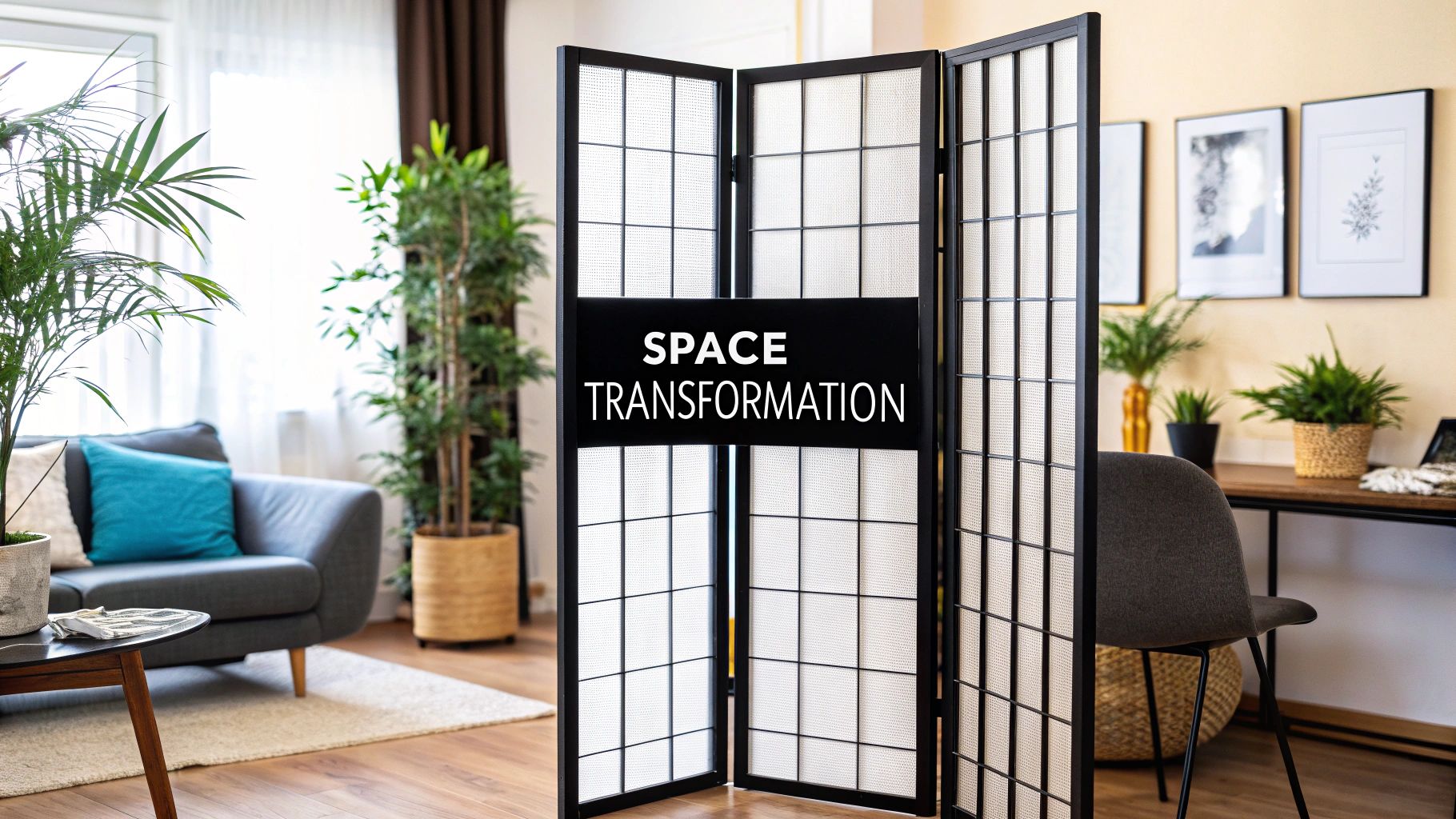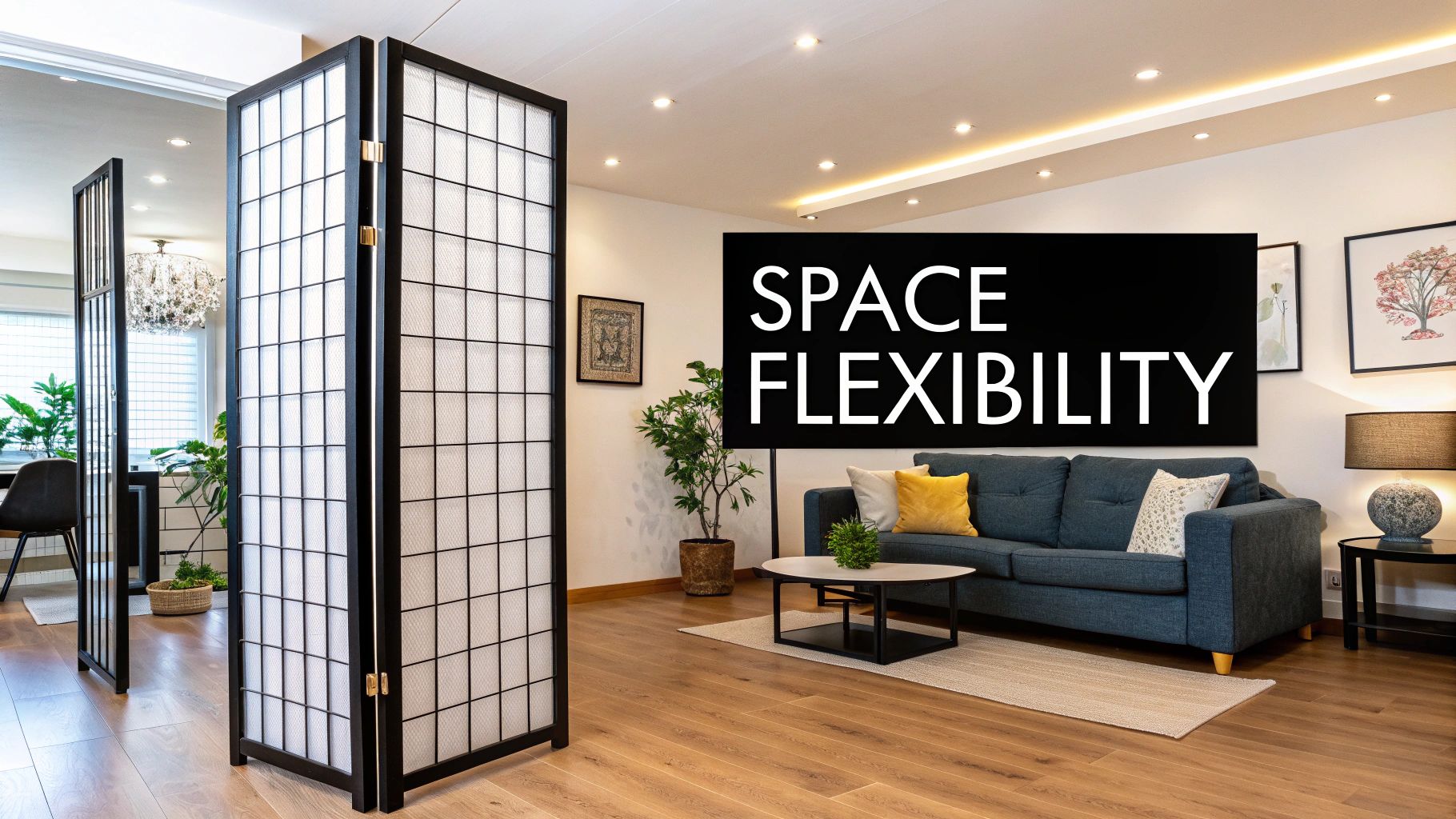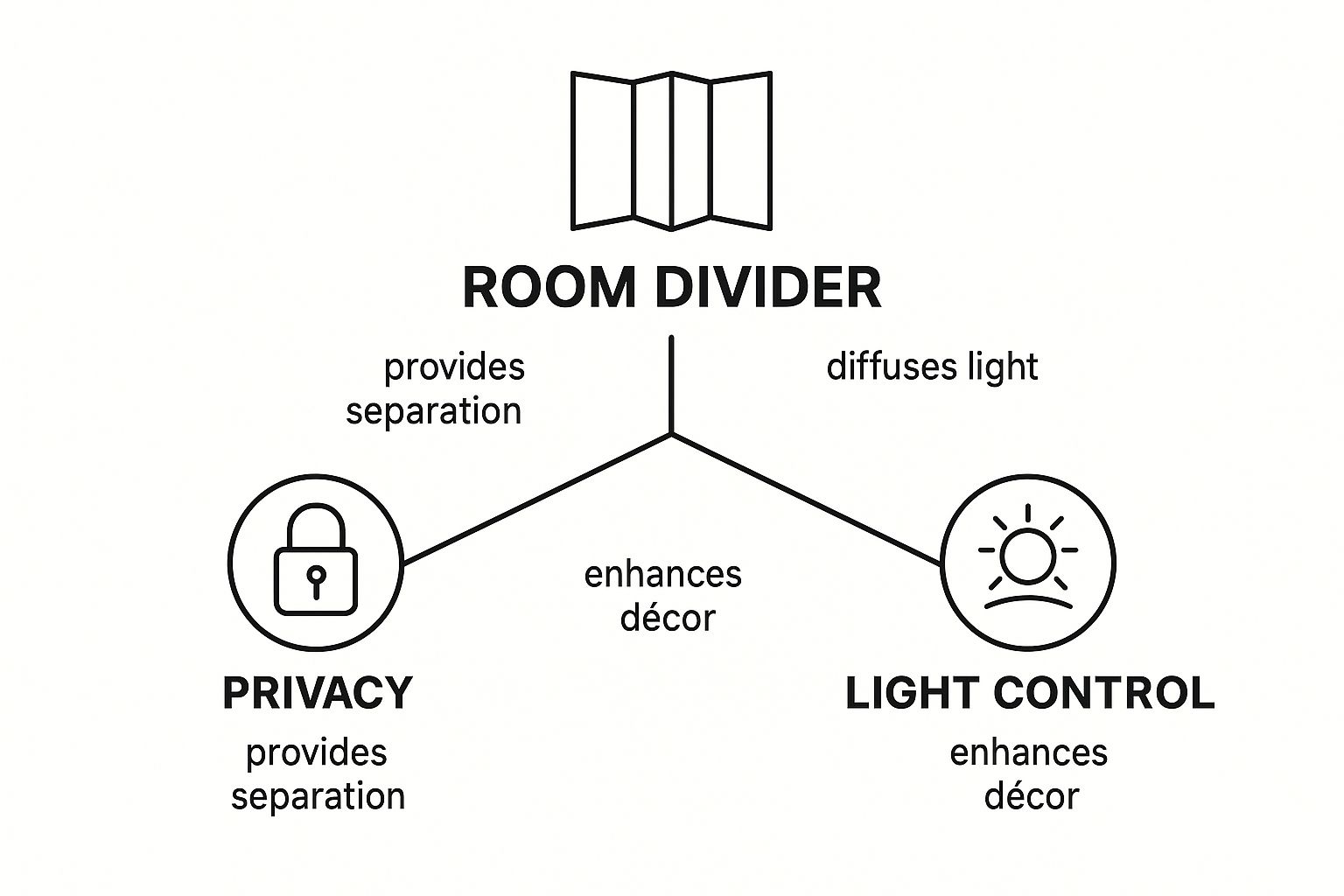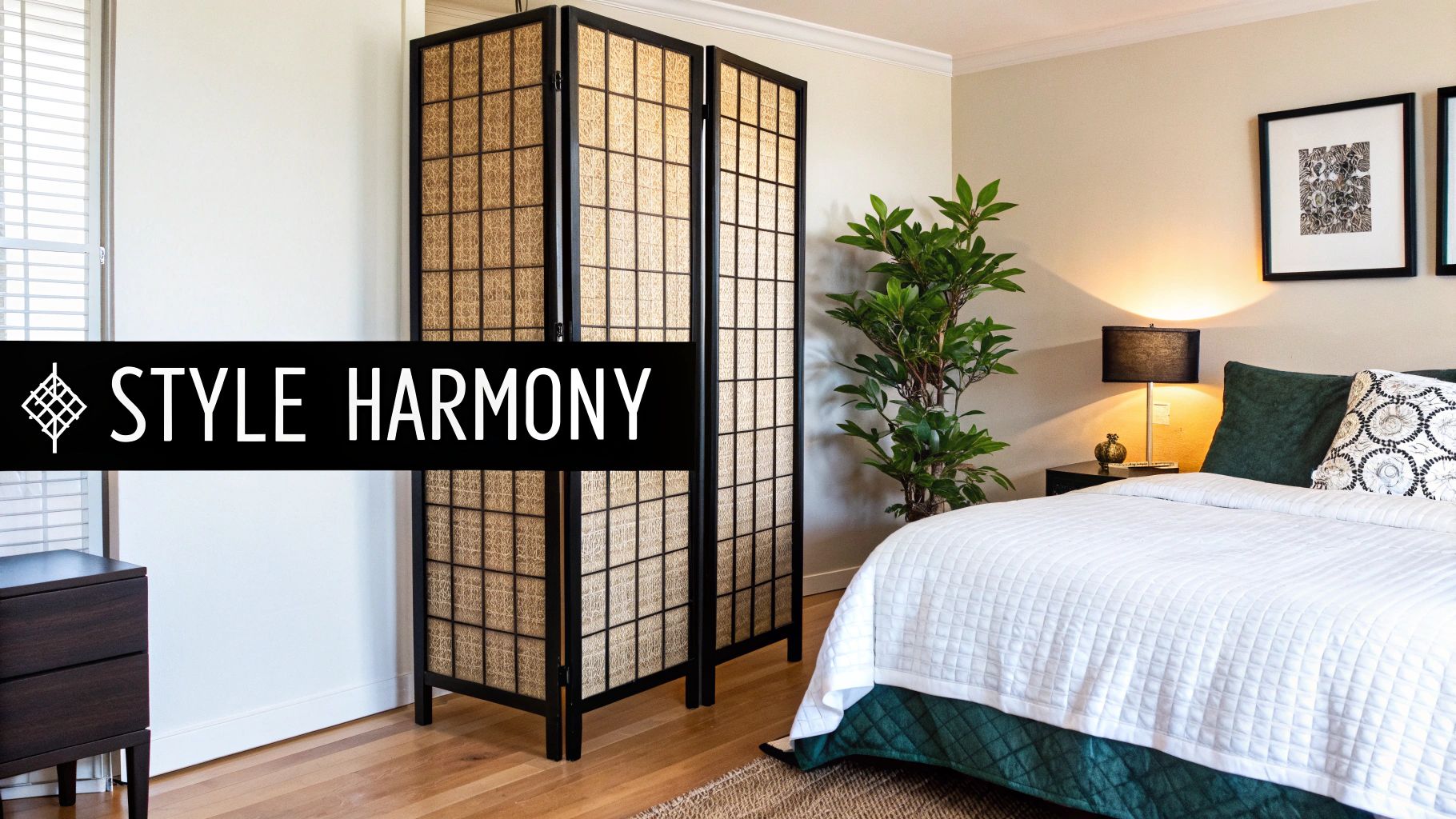Folding Screen Room Divider Guide: Easy Space Transformation

Understanding Folding Screen Room Dividers: Your Space's Swiss Army Knife
Think of a folding screen room divider as your space’s very own Swiss Army knife. It's more than just a partition; it's a flexible design tool that lets you instantly change how you use and experience your home. Imagine being able to create a quiet office corner in your living room for an afternoon of focused work, only to fold it away when friends come over for dinner. This adaptability is the real magic of these clever pieces of furniture. They offer a fluid solution to the fixed nature of walls, allowing your space to breathe and adapt to your daily needs.
More Than Just a Partition
A common misunderstanding is that a folding screen’s only job is to hide things. While it can definitely conceal a treadmill or a messy corner, its true potential is in its ability to define and create new zones within an open-plan area. For example, in a studio apartment, a thoughtfully placed divider can beautifully separate the sleeping area from the living space. This creates a sense of privacy and order without the cost or permanence of building a wall.
This simple addition can turn a single, large room into a more practical, multi-zoned home. The key is to view the screen as a deliberate design choice—a focal point that adds character, rather than an afterthought.
From Ancient Art to Modern Must-Have
The idea is hardly new, with a rich history that began in traditional Asian artistry. This heritage is beautifully shown in classical art, like the Japanese "Irises" screen by Ogata Kōrin.

This image shows how folding screens have long served as large-scale canvases for incredible artwork, mixing function with deep aesthetic value. Today, this tradition lives on with a modern spin. The contemporary folding screen room divider has evolved to suit the needs of today's homes. Modern versions use a wide range of materials, from sustainable woods and fabrics to lightweight, sound-absorbing panels perfect for a home office. They are no longer just static objects but customisable, high-performance tools made for flexible living, proving that great design ideas can endure while adapting to new challenges.
The New Zealand Space Revolution: Why Kiwis Are Going Flexible
Across New Zealand, a quiet but significant shift is happening in how we think about our homes. As our cities, like Auckland and Wellington, continue to grow, living spaces are becoming more compact. This has inspired Kiwis to find clever ways to make every square metre count. The old idea of having rigid, single-purpose rooms is making way for a more adaptable approach, where a space can easily change its function to match the needs of a modern household.
This change isn't just about dealing with smaller homes; it's also about our evolving lifestyles. Many of us need to create a quiet spot for a home office, a play area for the kids that can be packed away after bedtime, or a peaceful reading nook in the corner of a character home. The folding screen room divider has emerged as a hero in this movement, offering a simple and damage-free way to create these flexible zones.
Driving the Demand for Adaptable Spaces
The need for smarter space management is especially relevant in New Zealand's current housing market. For renters, making permanent changes isn't usually an option, which makes a portable divider the perfect solution for personalising a space without leaving a mark. Homeowners also love the freedom to adapt their homes for growing children or ageing parents without the expense and commitment of a full renovation.
This growing interest in flexible interiors is clearly reflected in market trends. Recent data shows the home organisation market is expanding, with modular folding screen room dividers making up about 15% of total home organiser sales volume in New Zealand by 2023. This highlights just how popular these versatile tools have become for Kiwis looking for functional, stylish solutions. You can learn more about the growth of flexible interior solutions in New Zealand.
This trend points to a bigger cultural move towards multifunctional living. A folding screen room divider is no longer just a decorative accent; it’s a practical tool that allows Kiwis to reclaim their space. It helps make our homes work harder for us, all while keeping the unique character and flow that makes a house feel like home.
When Home Became The Office: How Remote Work Changed Everything
The sudden move to remote work wasn't just about ditching the daily commute; it fundamentally redrew the floor plans of our homes. That open-plan living room, once the heart of social gatherings, suddenly needed to function as a professional workspace. Kitchen tables were commandeered as desks, and spare bedrooms became impromptu corporate headquarters. This new way of living created a pressing need for separation—not just physically, but mentally too. For countless Kiwis, the folding screen room divider became an unexpected hero in this new normal.
Creating Boundaries in a Boundaryless World
The biggest struggle of working from home is the erosion of boundaries between our professional and personal lives. When your office is always in your line of sight, it’s tough to mentally "clock off" for the day. A simple folding screen offers a graceful fix. By physically marking out a dedicated work area, it acts as a powerful psychological signal. Unfolding the screen in the morning can be a ritual to start the workday, while folding it away at night helps reclaim your living space for relaxation and family.
This simple act helps restore the work-life balance that many of us lost. Imagine a parent needing a quiet zone for video calls, visually shielded from the buzz of children learning online in the very same room. This wasn't just a fleeting need. The pandemic reshaped the market, with some reports showing an estimated 25% increase in demand for commercial and residential room dividers in New Zealand between 2020 and 2022. This spike was driven by people and businesses alike adjusting to new spatial needs. You can discover more about the commercial room divider market trends.
Beyond the Home Office: Versatile Solutions for Modern Life
Even as many of us adopt hybrid schedules or return to the office full-time, the usefulness of a folding screen room divider hasn't faded. It’s a brilliant tool for creating instant privacy for house guests, sectioning off a cosy reading nook, or even hiding away that treadmill you'd rather not look at. Its key strength is adaptability. A beautifully patterned screen, for instance, can double as a stylish, professional backdrop for video calls, instantly improving a makeshift home office.
Choosing the right design is key, as certain shades can even help with concentration. If you’re putting together a workspace at home, you might find our guide on colours to keep you focused and productive useful. These screens are more than just a relic of the pandemic; they are a permanent feature in smart, flexible home design, proving their worth long after the initial rush to set up a home office has passed.
Choosing Your Perfect Match: Materials, Styles And Smart Features
Not all folding screen room dividers are created equal, and this variety is exactly what makes finding the right one so rewarding. The best choice depends entirely on your space, lifestyle, and aesthetic. Think of it like choosing a vehicle; a zippy little car is perfect for city life, whereas a sturdy ute is better suited for rural work. In the same way, a lightweight fabric screen is great for renters needing portability, while a solid wood divider offers a permanent, stately presence.
The infographic below shows the core benefits a folding screen room divider brings to any space.

As you can see, these three key functions—Privacy, Light Control, and Aesthetic Appeal—are connected, showing how a single divider can solve multiple problems at once. Understanding this helps you prioritise what’s most important for your home.
Material World: From Fabric to Solid Wood
The material of your folding screen room divider determines its weight, durability, and visual texture. Here’s a quick rundown of the most common options:
- Fabric and Canvas: These are often the most affordable and lightweight choices. They excel at filtering light softly and come in endless colours and patterns. Their portability makes them a favourite for renters and those who often reconfigure their spaces. For eco-conscious homes, natural textiles like linen are an excellent choice. You can learn more about why linen is a sustainable choice for home furnishings.
- Wood and Rattan: Offering a more structural feel, wood dividers bring warmth and natural texture. Rattan or cane panels feel light and airy, fitting perfectly with coastal or boho-inspired decor. Solid wood panels, on the other hand, provide a substantial, classic look that can also help with sound dampening.
- Paper and Shoji Screens: Inspired by traditional Japanese design, these screens feature translucent paper that diffuses light beautifully, creating a calm and serene atmosphere. While visually stunning, they are more delicate and best suited for low-traffic areas.
- Mirrored and Metal: For a touch of glamour or an industrial edge, dividers with mirrored or metal panels can make a bold statement. Mirrors have the added benefit of making a room feel larger and brighter by reflecting light.
To help you decide, we've put together a table comparing the most popular materials for folding screen room dividers.
Folding Screen Room Divider Materials Comparison
A comprehensive comparison of popular materials used in folding screen room dividers, including durability, cost, and best use cases.
| Material | Durability | Cost Range | Best For | Maintenance |
|---|---|---|---|---|
| Fabric/Canvas | Moderate | Low to Mid | Renters, temporary setups, adding colour and pattern | Spot clean, may need occasional tightening or steaming |
| Wood/Rattan | High | Mid to High | Long-term use, sound dampening, natural aesthetics | Dust regularly, use wood polish for solid panels |
| Paper/Shoji | Low | Low to Mid | Low-traffic areas, creating ambient light, serene decor | Very gentle dusting; avoid moisture and impact |
| Mirror/Metal | High | Mid to High | Small spaces, modern/industrial decor, reflecting light | Regular cleaning with glass or metal cleaner |
This table shows there’s a material to suit every need and budget. Whether you prioritise affordability with fabric or longevity with solid wood, the right choice will serve its purpose beautifully.
Smart Features and Modern Styles
Beyond traditional materials, today’s dividers come with some clever features. Some models now incorporate sound-absorbing acoustic foam, perfect for carving out a quiet home office nook. Others have modular designs, allowing you to add or remove panels as your needs change.
This screenshot from IKEA's New Zealand site shows the variety of styles available, from simple fabric panels to intricate woven designs.

This highlights how accessible retailers cater to diverse tastes, ensuring there is a folding screen room divider for every Kiwi home, whether your style is minimalist, eclectic, or somewhere in between.
Styling Secrets: Making Your Divider Look Intentionally Amazing

A folding screen room divider can be more than just a practical partition; it can be the centrepiece of your room’s design. The trick is making it feel like a deliberate, integrated element rather than a temporary fix. Think of it less as a wall and more as a large, sculptural piece of furniture. When styled with a bit of thought, it can anchor a space, add layers of texture and colour, and change the whole feel of a room from functional to fabulous.
The key is to avoid having the screen stand alone, which can make it look like it's simply hiding something. Instead, you want to create a vignette—a small, curated scene—that grounds the divider and gives it purpose. This simple technique is what turns a practical item into a stunning design feature that draws the eye for all the right reasons.
Anchor Your Screen with Purpose
To make your divider look intentional, anchor it with other pieces of furniture. This simple move tells a story about how the space is meant to be used. Placing a comfy armchair and a small side table in front of your screen instantly creates an inviting reading nook. This not only defines the new zone but also makes the screen a part of the room’s overall design. It becomes a beautiful backdrop, making the corner feel cosy and private.
In a living room, you could place the divider behind a sofa to add depth and visual interest. In a bedroom, using it as a decorative headboard is a classic designer move that adds a touch of drama and elegance. The goal is to make the screen part of a larger arrangement. Consider these ideas:
- Create a Reading Nook: Position a plush armchair, a floor lamp, and a small stack of books in front of the screen.
- Define a Dining Area: In an open-plan space, use a long, low sideboard in front of the divider to visually separate the dining zone from the living area.
- Build a Dressing Corner: Pair the screen with a stylish full-length mirror and a small stool to carve out a private dressing space in a bedroom.
Layer with Light and Greenery
Lighting and plants are your secret weapons for integrating a folding screen room divider. A well-placed floor lamp can cast a warm, inviting glow, highlighting the texture or pattern of the screen and turning it into a real feature, especially in the evening. This also helps to soften the edges and make the division feel less stark.
Adding plants brings life and organic texture to the setup. A tall, leafy plant like a Fiddle Leaf Fig placed beside the screen can help blur the lines and add a sense of height. For smaller spaces, a hanging plant near the top corner can draw the eye upward, making the ceiling feel higher. These finishing touches, much like adding cushions to a sofa, bring a space to life. You can discover more styling principles for how to decorate with cushions to transform your space. By using these simple strategies, your divider will look amazing and feel like it was always meant to be there.
Real Solutions For Real Homes: Practical Applications That Work
Beyond pure style, the real magic of a folding screen room divider is its knack for solving everyday household puzzles. Think of it as a flexible boundary that reshapes your space to match the rhythm of your day. A single divider can wear many hats—transforming from a professional home office background for your morning video calls, to a designated play area barrier in the afternoon, and finally into an elegant backdrop for your evening dinner party.
Multi-Purpose Configurations
The secret to getting the most out of a divider is seeing its potential to create distinct zones. This is a game-changer in open-plan homes where one activity can easily spill into another, creating a sense of chaos. Let's look at some real-life examples from Kiwi homes:
- The Dedicated Play Area: In a busy family living room, a sturdy, easy-to-clean divider can section off a corner just for kids' toys. This simple boundary contains the creative mess and gives children a clear signal for where their play zone ends, making tidy-up time far less of a battle. When guests arrive, the screen folds away in seconds.
- The Instant Guest Room: If you don't have a spare bedroom, a substantial folding screen can create a private, cosy sleeping space for visitors. Paired with a sofa bed in the lounge, it gives your guests a sense of their own room without needing permanent walls. Screens around 1.8 metres high are perfect for this.
- The Organised Storage Zone: Many of us have a corner we’d rather keep out of sight, whether it’s exercise equipment, a sewing machine, or craft supplies. A strategically placed screen can elegantly hide these functional but less-than-beautiful parts of a room, helping you maintain a calm and uncluttered atmosphere.
To help you visualise how a folding screen can work in your own space, we've put together a table outlining practical applications for different rooms.
Folding Screen Room Divider Applications By Room Type
Practical applications and benefits of using folding screen room dividers in different areas of the home
| Room | Primary Use | Secondary Benefits | Recommended Height | Style Considerations |
|---|---|---|---|---|
| Living Room | Create a reading nook or separate a TV area. | Hides clutter, adds a decorative focal point. | 1.7m - 1.8m | Match with sofa upholstery or wall art. |
| Bedroom | Section off a dressing area or create a small WFH space. | Adds privacy, provides a backdrop for a headboard. | 1.8m+ | Choose calming colours or luxe materials like velvet. |
| Studio Apartment | Separate sleeping and living areas. | Creates the illusion of multiple rooms, adds personality. | 1.8m+ | Mirrored panels can make the space feel larger. |
| Home Office | Conceal office equipment after hours. | Provides a professional, non-distracting video call background. | 1.7m - 1.8m | Solid, neutral colours work best for professional settings. |
| Dining Area | Screen off the kitchen view or create an intimate setting. | Reduces noise from the kitchen, adds elegance. | 1.7m+ | Choose a design that complements your dining table and chairs. |
This table shows just how adaptable these pieces can be. The key is to match the divider's height, material, and style to the specific job you need it to do in each room.
Solutions for Common Challenges
A frequent question is how a folding screen room divider will perform in a space with unique quirks. For homes with slightly uneven floors, look for dividers that have adjustable feet to ensure they stand firm and stable. They are also a brilliant solution for renters, as they allow you to create division and privacy without drilling a single hole or leaving a mark.
If you share your home with pets or young children, choosing a heavier, more stable material like solid wood or a robust metal frame can prevent accidental knock-overs. In rooms with soaring ceilings, a taller screen can make a dramatic statement and draw the eye upward. Conversely, in a smaller room, a divider with mirrored panels can create a wonderful illusion of depth, making the space feel much larger than it is. By pairing the right divider with your specific challenge, you open up a world of practical, stylish possibilities.
Custom Solutions and Sustainable Choices: The Maak Home Approach
While an off-the-shelf room divider might do the job, a truly perfect folding screen room divider is one that speaks to your personal style and fits your space flawlessly. This is where customisation turns a practical item into a statement piece. Instead of choosing a mass-produced design, picture a divider finished in a fabric that perfectly complements your curtains or wallpaper, creating a cohesive, high-end look. This is the heart of what we do at Maak Home: create pieces that aren’t just for a space, but are a genuine part of it.
This tailored approach also supports a growing desire for more sustainable living. Opting for a custom-made piece means you're investing in quality that is built to last, which is a conscious step away from throwaway culture. It’s about being more mindful of what we buy and the environmental impact of our homes.
The Value of Conscious Creation
Sustainable manufacturing isn't just about the final product; it's a promise to use responsible methods from the very beginning. Key parts of this include:
- On-Demand Production: We only print and create what has been ordered. This zero-waste approach stops the cycle of overproduction that so often leads to landfill waste, a major problem in the home furnishings industry.
- Eco-Friendly Materials: The materials we select matter a great deal. By focusing on sustainable textiles and non-toxic inks, we make sure our products are safe for your home and gentler on the planet. You can learn more about our commitment in our guide to top green upholstery material ideas.
- Local Manufacturing: By producing everything right here in New Zealand, we significantly cut down on shipping emissions and proudly support local artisans and craftsmanship.
Tailored to Your Vision
Investing in a custom folding screen room divider is about creating a solution for the long run. It's a versatile piece that can change with you, from sectioning off a temporary nursery nook to later creating a private study corner for a teenager. With choices from simple colour matching to intricate, completely custom-printed designs, you have the freedom to design something that is uniquely yours. This ensures your divider will be a treasured feature in your home for years to come, blending beautiful design with responsible choices.
Ready to create a piece that perfectly fits your home and your values? Explore the endless possibilities with Maak Home and bring your vision to life.









